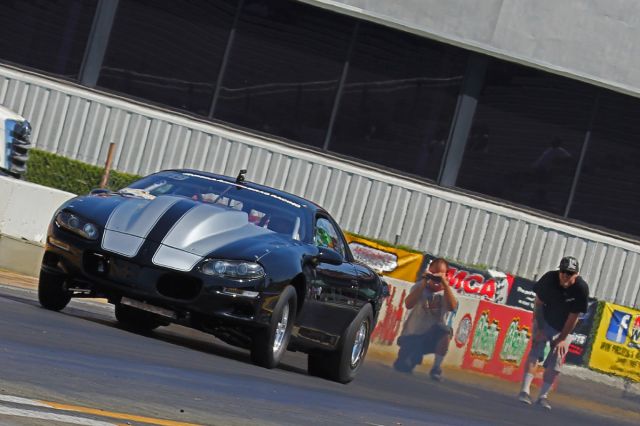When you take three hundred and eighty-eight cubic inches of ProCharged LSX small-block, fill it with JE pistons that compress the incoming air/fuel mixture eleven-point-eight times smaller than its original dimension, and stick a ProCharger [2] F-1R supercharger in front of the air to help it along, you’ve got one nasty air pump. An air pump like that needs lots of spark and lots of fuel. But what it also needs is a way to monitor how that air and fuel is being turned into horsepower, whether it is on the edge of eating itself or achieving that optimum mixture burn rate.
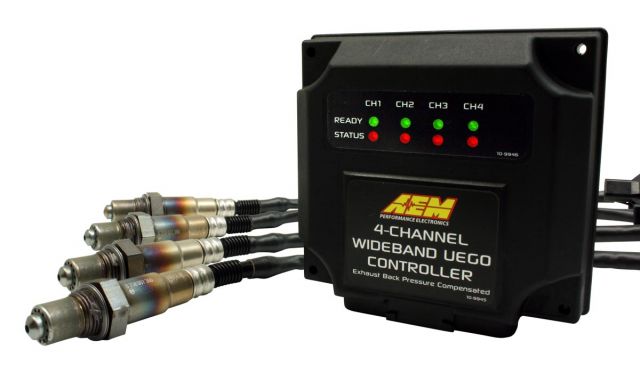 [3]
[3]AEM Performance Electronics' 4-Channel Wideband UEGO Controller can monitor four cylinders with precision accuracy. You need two of these for a V8 - it's well worth the investment on a forced-induction car.
That’s where AEM Performance Electronics [4] entered the picture of our BlownZ project, setting us up with not one, but two of their awesome 4-channel Wideband UEGO controllers. These things are state-of-the-art engine tuning tools, using a single oxygen sensor for each hole, instead of having one sensor for each bank (usually in the exhaust collector) and averaging the results.
We detailed its operation back in April in this article [5] and explained the inner workings of the hardware. At that time, AEM’s Lawson Mollica told us that the four-channel unit his company offers has a quicker response time since the sensors can be placed only three to five inches from the exhaust valve in the header. And when you’re able to control individual cylinder tuning as we are with our XFI 2.0 engine management system, you better believe this becomes a tuning advantage.
As discussed in the previous article, each sensor bung must be installed right off the cylinder head and header flange in order to get the best results, and the bung must be placed into the header tube at an angle greater than ten degrees from horizontal to prevent liquids from collecting, according to Mollica. But other than that, there’s not much to setting them up.
The Bosch 4.2LSU sensors are pre-calibrated from the factory, and never require calibration when used with an AEM controller. If you’re running a turbo combination you’ll want one of AEM’s Exhaust Back Pressure Compensation kits, which allows accurate AFR readings that aren’t affected by turbo backpressure – you can stick one in each hole pre-turbo and gain the maximum amount of performance out of your hot rod. That’s about all you’ll need except for someone who knows how to weld to install the bungs.
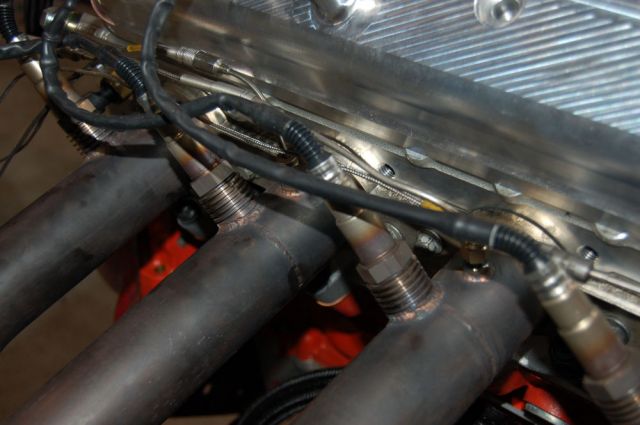 [6]
[6]The unique heat-sink design of the oxygen sensor bungs allows then to be placed in the perfect position to monitor each cylinder closely.
Learning From The Datalogs
Getting away from the hardware and into the software, we have actual track data to report, as we took our project car to the NMCA West Street Coast Shootout over the weekend of August 17th-19th at Pomona Fairgrounds in California. It was a mad thrash in the days leading up to the race to get the car ready to make its NMCA event debut, although we had previously made a few shakedown runs. Once we arrived at the event, the crew learned quite a bit from their efforts and were able to make solid tuning changes – made possible by the data we could now interpret thanks to our AEM 8-wideband oxygen sensor setup.
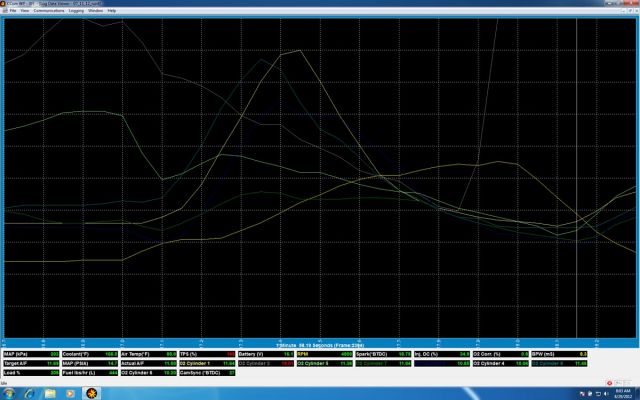 [7]
[7]Here on the dyno, pre-race during testing, you can see where cylinder No. 3 went super-lean when the spark was blowing out. We had to move up to a MSD 8 ignition box to address this issue. Without the AEM data, we would have been guessing forever.
Prior to our track outing, we were able to see on the dyno how the engine was performing, and having a sensor in each hole helped us to pinpoint where our issues were for the initial tune. With the 11.8:1 compression ratio we’re running in this engine combined with our 22 psi boost levels, we had to eventually go to an MSD 8 box and .016″ gap to fire it – thanks to the AEM eight widebands we could see the cylinders blowing out on the dyno and that was invaluable. We tested in Barona and made a couple of passes at Pomona before figuring out our issues. We were also running a -10 spark plug and it was too cold, so that didn’t help.”
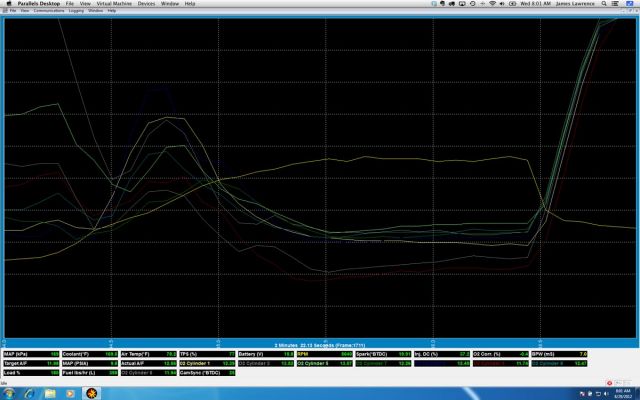 [8]
[8]In this log, you can see where we were able to keep the air/fuel ratio much closer after upgrading the ignition. Final individual cylinder tuning will come at the track under real-world conditions.
A sensor in each hole helped us to pinpoint where our issues were for the initial tune.
We felt that the eight sensors made it a much simpler challenge to dissect all of the tuning information, by being able to tie the air/fuel ratio to the rest of the data compilation from the logger. The system has also helped determine that there are more improvements that we can make that will be covered in a future article. We integrated our AEM wideband sensors into our XFI system using the standalone analog inputs, and while at the track we were able to check out what was happening after each pass thanks to its datalogging capabilities and tune our engine one cylinder at a time to ensure optimal combustion.
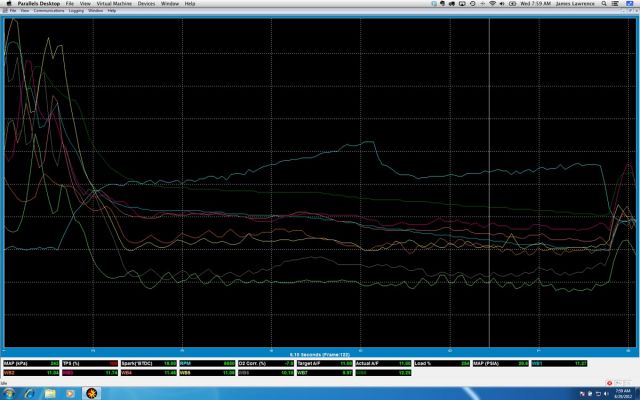 [9]
[9]We found that at 6.1 seconds into the run, cylinders six, seven, and eight all showed non-optimal burn rates. This shows us where improvements can be made for the future.
Having the ability to track the air-fuel ratio and manage it against many RPM and time points showed an accurate picture of what was happening in the engine at any given point in the run. While we battled the car and the track every step of the way this weekend, the task was made easier thanks to the tuning that knowledge allowed us to perform. What exactly were we looking at? Check it out. The datalogs from the track prove that the air-to-fuel ratio in a couple of cylinders is off compared to the rest – setting the stage for future improvements. By looking at air/fuel ratio data points ranging from peak RPM to specific time increments throughout the run, we are able to make informed tuning corrections after each pass.
There is no doubt in our minds that the AEM dual four channel system is “worth the squeeze”, as they say an invaluable tuning aid.


